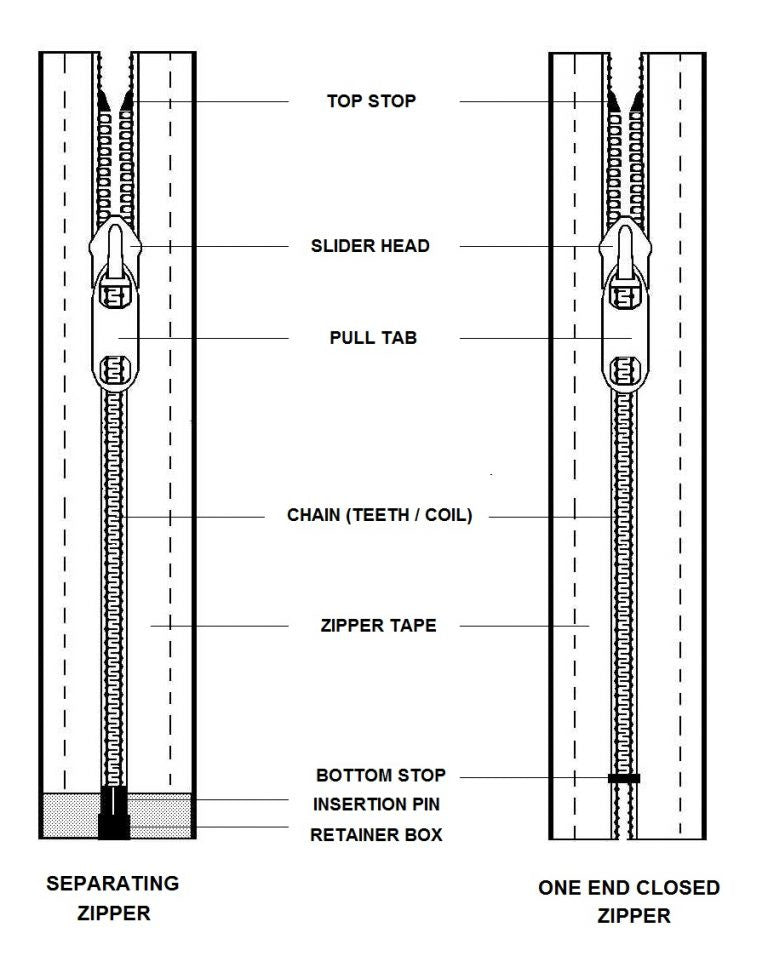
Everything you need to know about zipper
Zippers are everywhere from our pants and jackets to sleeping bags and backpacks. They’re far more convenient than a row of buttons or snaps and can be opened and closed in a matter of seconds. For these conveniences, zippers are used so often for a variety of products around the world.
Zipper Mechanics
Because zippers are used in a range of products, both heavy-duty and not, utilizing a variety of different materials and fabrics, there are of course multiple types. You wouldn’t use a basic nylon coil zipper on a 3-season tent or a heavy duty travel backpack. With each type of zipper, there are suggested products and uses, as well as quality standards.
In order to understand the types of zippers, you must first be familiar with the anatomy of each zipper to understand the individual roles of each piece.
Below is a diagram of a separating zipper on the left and a closed-end zipper on the right. Both have more or less the same anatomy other than a few differences at the bottom.

Different Types of Zippers
There are five common types of zippers that can be found on a range of products in your every day life. Below are the names of each type of zipper as well as their most common uses:
Separating Zipper (Open-End)
Commonly found on jackets, vests and other outerwear, a separating zipper allows both side of the tape to come apart completely when the zipper is fully undone.

Closed-End Zipper
Look at the trousers in your closet or the cute, leather boots you bought last month in the front hall, the zippers you see on these products are closed-end zippers. This type of zipper does not separate at the bottom (unless it’s broken).
Two-Way Separating Zipper
A two-way separating zipper can be found on a sleeping bag, a rain coat and on winter parkas. These zippers allow an item to be fully zipped at the top while also being able to be unzipped at the bottom.
Two-Way Head-to-Head Zipper
Mainly found on backpacks and travel bags, when done up, these zippers will have two sliders face-to-face in the center of the teeth or on one side of the bag. The ends of the two zippers have two stops which cannot be divided or separated so the two tape sides remain attached like a closed-end zipper.
Two-Way Tail-to-Tail Zipper
For this particular type of zipper, there are sliders at opposite ends of the teeth when the zipper is fully closed. The sliders glide along the same teeth and because they are back-to-back, they cannot be separated.
Different Types of Zipper Teeth
Zippers are available in different levels of durability and utilize different types of materials. Certain materials are known for being more heavy duty and durable than the others but each will have specific products where they are used often and succeed at their role.
Below are the main categories of materials used for zipper teeth.

Metal
When zippers were first created between 1917 and 1920, they were made with metal teeth. The teeth were molded and placed on both sides of the tape in a way that when the zipper closed, the teeth would fit together firmly like a puzzle.
They are used on a variety of items and are available in multiple finishes. The Most common finished are aluminum, brass, antique brass and black oxidized.

Molded Plastic
A zipper with molded plastic teeth is similar to that of a zipper made of metal teeth with the only difference being the teeth are molded out of plastic. These teeth are manufactured with high performance resins making them extremely strong resulting in very durable and flexible zippers.
Molded plastic zippers are ideal for most outdoor products and are especially common in outerwear.
Invisible
Invisible zipper teeth are most common in fashion products like on the back of dresses, skirts or some pants. The slider is generally very small and in the shape of a tear drop.
These zippers are known as invisible zippers because once closed, the teeth are no longer visible. This is because the zipper teeth are located on the backside of the actual zipper.

Coil
These are the most common types of zipper teeth because they are lightweight, rustproof and heat resistant. Although they were originally made using nylon, nowadays, they are more typically made from polyester.
Coil zipper teeth are used on a variety of products from wallets and purses and occasionally on some clothing items.
Every accessory is very important for garments; we attach great importance to quality of garments as well as accessory.
Thanks very much!
Vimost sports team
Leave a comment





